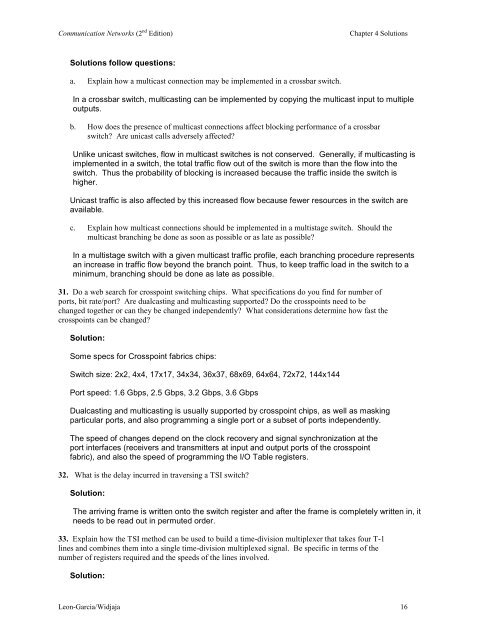Solutions to Chapter 4 - Communication Networks
Solutions to Chapter 4 - Communication Networks
Solutions to Chapter 4 - Communication Networks
Create successful ePaper yourself
Turn your PDF publications into a flip-book with our unique Google optimized e-Paper software.
<strong>Communication</strong> <strong>Networks</strong> (2 nd Edition)<br />
<strong>Chapter</strong> 4 <strong>Solutions</strong><br />
<strong>Solutions</strong> follow questions:<br />
a. Explain how a multicast connection may be implemented in a crossbar switch.<br />
In a crossbar switch, multicasting can be implemented by copying the multicast input <strong>to</strong> multiple<br />
outputs.<br />
b. How does the presence of multicast connections affect blocking performance of a crossbar<br />
switch Are unicast calls adversely affected<br />
Unlike unicast switches, flow in multicast switches is not conserved. Generally, if multicasting is<br />
implemented in a switch, the <strong>to</strong>tal traffic flow out of the switch is more than the flow in<strong>to</strong> the<br />
switch. Thus the probability of blocking is increased because the traffic inside the switch is<br />
higher.<br />
Unicast traffic is also affected by this increased flow because fewer resources in the switch are<br />
available.<br />
c. Explain how multicast connections should be implemented in a multistage switch. Should the<br />
multicast branching be done as soon as possible or as late as possible<br />
In a multistage switch with a given multicast traffic profile, each branching procedure represents<br />
an increase in traffic flow beyond the branch point. Thus, <strong>to</strong> keep traffic load in the switch <strong>to</strong> a<br />
minimum, branching should be done as late as possible.<br />
31. Do a web search for crosspoint switching chips. What specifications do you find for number of<br />
ports, bit rate/port Are dualcasting and multicasting supported Do the crosspoints need <strong>to</strong> be<br />
changed <strong>to</strong>gether or can they be changed independently What considerations determine how fast the<br />
crosspoints can be changed<br />
Solution:<br />
Some specs for Crosspoint fabrics chips:<br />
Switch size: 2x2, 4x4, 17x17, 34x34, 36x37, 68x69, 64x64, 72x72, 144x144<br />
Port speed: 1.6 Gbps, 2.5 Gbps, 3.2 Gbps, 3.6 Gbps<br />
Dualcasting and multicasting is usually supported by crosspoint chips, as well as masking<br />
particular ports, and also programming a single port or a subset of ports independently.<br />
The speed of changes depend on the clock recovery and signal synchronization at the<br />
port interfaces (receivers and transmitters at input and output ports of the crosspoint<br />
fabric), and also the speed of programming the I/O Table registers.<br />
32. What is the delay incurred in traversing a TSI switch<br />
Solution:<br />
The arriving frame is written on<strong>to</strong> the switch register and after the frame is completely written in, it<br />
needs <strong>to</strong> be read out in permuted order.<br />
33. Explain how the TSI method can be used <strong>to</strong> build a time-division multiplexer that takes four T-1<br />
lines and combines them in<strong>to</strong> a single time-division multiplexed signal. Be specific in terms of the<br />
number of registers required and the speeds of the lines involved.<br />
Solution:<br />
Leon-Garcia/Widjaja 16







